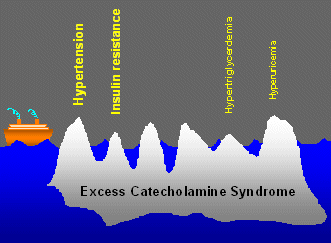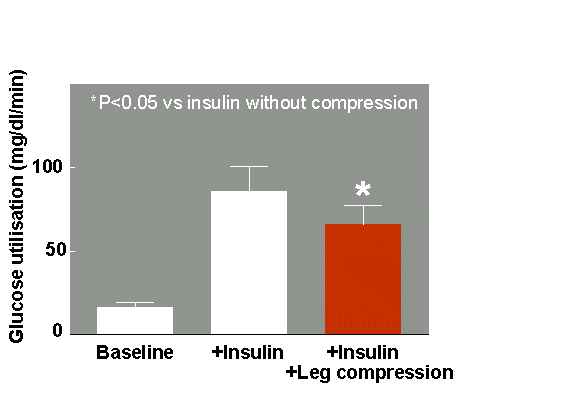

The unfavorable effects
of a
raised sympathetic activity can be shown in normal persons after reflex
stimulation
of the sympathetic nervous system. In the experiment by Jamerson et al.
(2),
a supraphysiological dose of insulin was infused using the euglycemic
hyperinsulinemic
clamp technique. The increased insulin resulted - as expected - in a
higher
glucose utilisation. When a bilateral thigh compression was used to
reduce
the venous return to the heart, the glucose utilisation was impaired!
Various cardiopulmonary
receptors monitor the venous filling of the heart and induce a rise in
sympathetic
outflow of the brain when venous return is reduced or the pressure
development
of the heart is depressed. As a consequence of the increased
sympathetic
activity, glucose utilization of the body is reduced. The study shows that reflex
changes in
sympathetic tone that are in the normal range of human physiological
responses can induce insulin resistance. It appears that a raised
sympathetic activity due to a high caloric intake has a similar action.

Since insulin
resistance precedes diabetes mellitus type-2, interventions which
interfere with progression of insulin resistance are of utmost
importance. Since moxonidine interferes with various adverse mechanisms
that promote insulin resistance, it is not unexpected that it increases
insulin sensitivity also in overweight or obese subjects. In our
opinion, hypertension therapy should include an intervention that
reduces insulin resistance, as is the case with moxonidine.
1. Rupp H: Excess
catecholaminesyndrome. Pathophysiology and therapy. Ann N Y Acad Sci
1999;881:430-44.
2. Jamerson KA,
Julius S, Gudbrandsson T et al. Hypertension 1993;21:618-623.